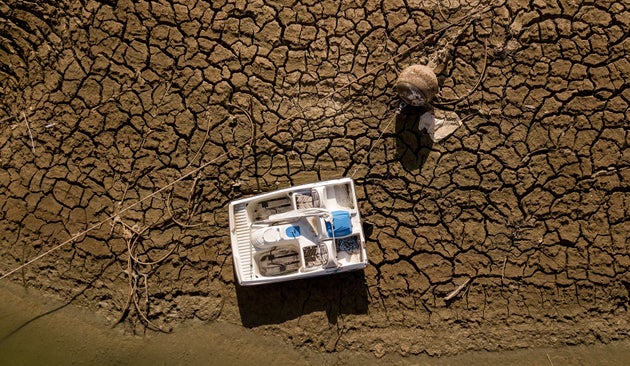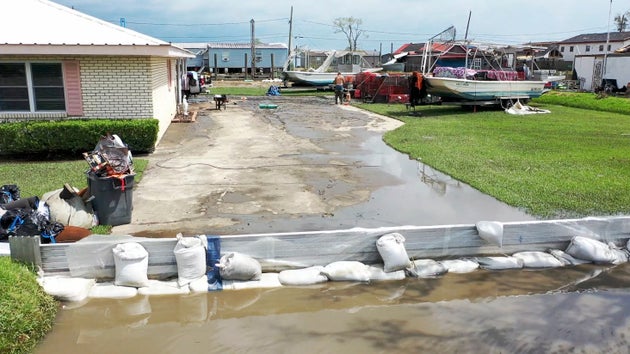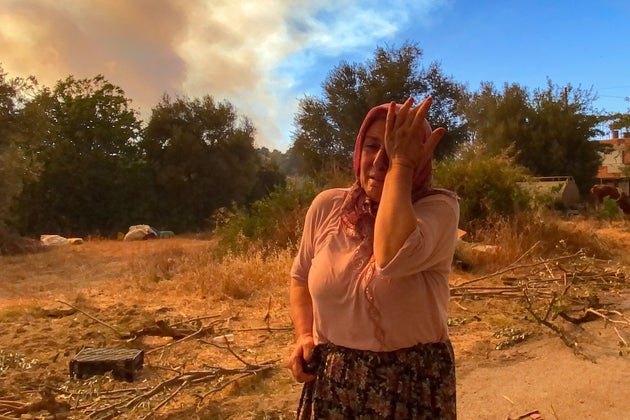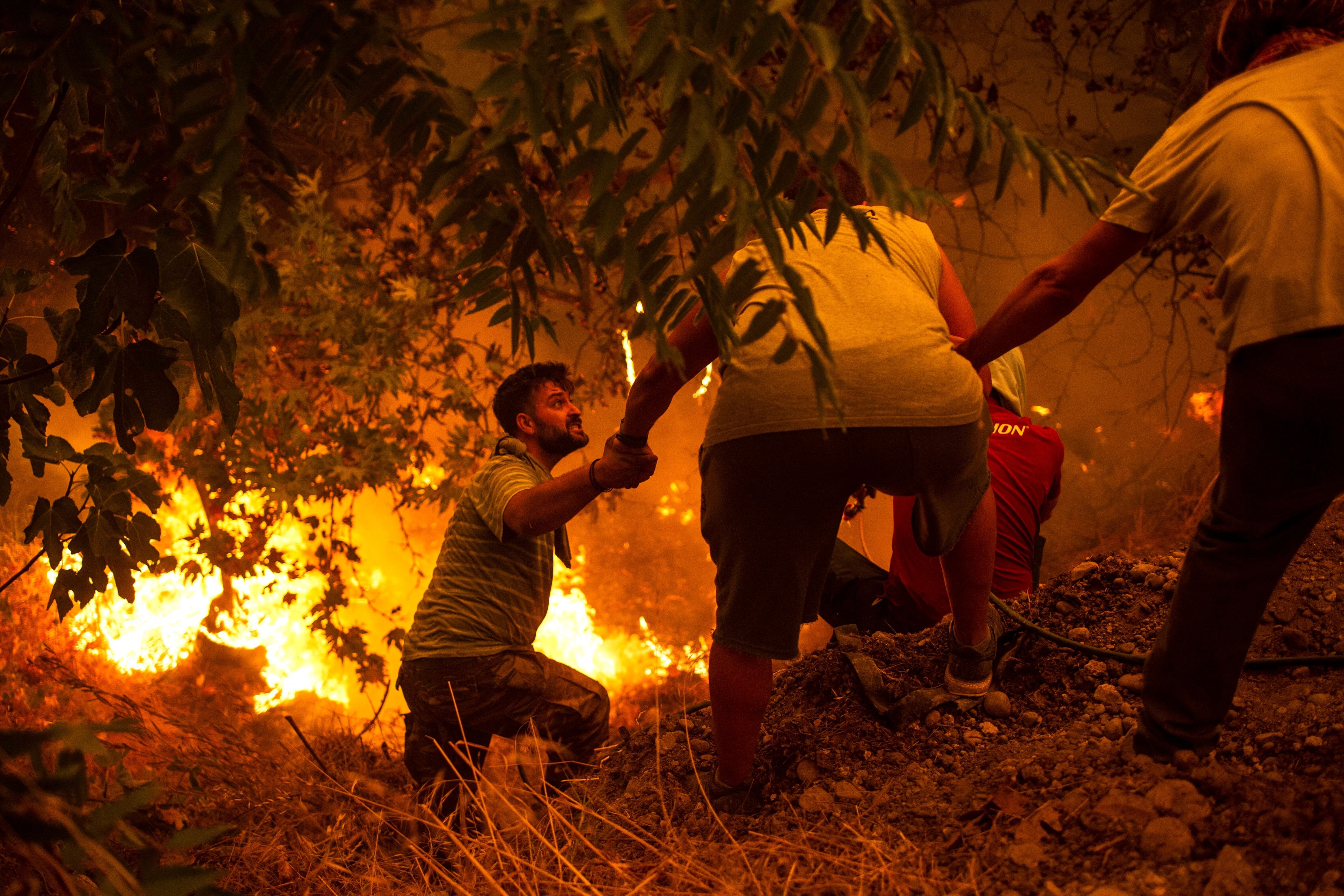Pollution-fuelled climate change has already irreversibly damaged civilisation and nature alike, and, while cities have begun to fortify themselves, the catastrophic new temperatures the planet is on track to reach in the coming decades will render much of that adaptation futile.
That’s the alarming finding of the United Nations’ latest temperature-check on global warming.
The report from the Intergovernmental Panel on Climate Change (IPCC), the world’s premier climate research body, provides a sweeping analysis of climate impacts and vulnerability, a summary of which was released Monday, asserting that “the extent and magnitude of climate change impacts are larger” than past UN assessments.
The conclusions are broadly described and inherently conservative, the result of a consensus process between 270 top scientists from 67 countries whose competing political interests are perhaps best illustrated by the omission of clear language about such issues as fossil fuels, nuclear power, carbon dioxide removal technology and methane gas.
A study from another of the IPCC’s working groups, focusing on solutions, is due out next month, and will likely tackle more of those thorny topics.
But the report emphasises what millions of people can already intuit from dramatic shifts in weather patterns: Ways of life that sustained generations are coming to an abrupt and chaotic end, causing great suffering that world governments’ responses so far have proven woefully inadequate to ease, much less reverse.
“We simultaneously need to reduce our greenhouse gas emissions, adapt to reduce the risks of climate change and address losses and damages that are already being experienced,” Adelle Thomas, an author of the report and researcher at the University of Bahamas, said in a call with reporters. “And we have a very limited amount of time to do this.”
The effects of warming have already spread deadly diseases and increased mental illnesses. A mass exodus has begun as people in every region of the globe flee homes made inhospitable by climate change, with small island nations hit hardest.
Drought and flooding is driving food insecurity and malnutrition in Africa, Central and South America. Ecosystems on every continent, in every topography, and in all oceans have experienced changes in structure and locations where animals and plants live as a result of warming that the report’s authors can attribute to warming with high degrees of certainty.

There are myriad ways human societies can change to bend the curve of warming, including more nature conservation, a rapid shift to zero-carbon energy sources, and near-infinitely more financial resources devoted to cutting the output of planet-heating gasses and distributed far more widely among the world’s almost eight billion people.
But so far, “lack of funding, lack of political capacity and governance, [and] lack of commitment” have kept the planet on a devastating trajectory, said William Solecki, a co-author of the report and geographer at the City University of New York’s Hunter College.
“The cumulative scientific evidence is unequivocal: Climate change is a threat to human well-being and planetary health,” the report’s summary concludes. “Any further delay in concerted anticipatory global action on adaptation and mitigation will miss a brief and rapidly closing window of opportunity to secure a liveable and sustainable future for all.”
Here are some of the key takeaways from the new report:
1. People increasingly understand climate change is happening, but that isn’t translating into a proportionate response.
What was long treated as a far-off threat is now a tangible part of life on Earth. Rising seas are swallowing low-lying islands and inundating coastal communities. Excessive drought is causing water shortages in the US Southwest and Africa. Violent storms and heavy rains are wreaking havoc across the globe. And warming ocean waters are causing coral reefs to collapse and fisheries to quickly move toward the poles.
Still, nations are dragging their feet when it comes to confronting planetary warming.
“Globally, the issue of climate change has become quite well understood and that has increased public awareness,” Solecki said. “That has not translated into significant actions.”
In North America, climate misinformation and the politicisation of climate science remain ongoing barriers to aggressive climate action, the report notes. As if to serve as an exclamation point to that finding, the US Supreme Court — staffed by a supermajority of right-wing justices, including at least one who questions the science of climate change and has direct family ties to the oil industry — is scheduled to begin hearing a case that could limit the federal government’s ability to regulate carbon emissions.

2. Humans are adapting to climate change, but it’s not even close to enough — and what little is being done becomes less effective as temperatures rise.
The world has made progress adapting to mounting climate impacts, but researchers found that those efforts have been “fragmented,” “unequally distributed” and largely targeted at dealing with water problems. It’s already far from enough and, once we hit higher temperatures, it’ll be even less helpful.
“The earlier the adaptation measures are implemented, the more the world will benefit because the potential to reduce climate risks through adaptation is higher until mid-century,” notes an FAQ released alongside Monday’s report. “At higher levels of warming, the effectiveness of most land- and water-based adaptation options starts declining, and the extent of residual risks increases, as do the chances of future unintended consequences.”
3. In many places, societies are “maladapting” — taking steps to protect themselves against climate change that actually make things worse.
In the face of climate disasters, many governments are taking a shortsighted, counterproductive approach to adaptation that not only fails to look holistically at climate impacts over time, but may worsen them.
This includes building “inflexible infrastructure that cannot be adjusted easily or affordably” — think new construction projects on waterfronts that, even under optimistic scenarios, are slated to be underwater in the next few decades. It also means fortifying certain parts of cities, for example, while leaving out vulnerable communities “which cannot afford to move or adapt.”

4. Adaptations are largely focused on cities — but urban slums and rural areas are excluded.
Since 2010, more of the world’s population has lived in cities than rural areas. As a result, strategies to hunker down in the face of climate problems — either with more air conditioning on hot days or better planning to deal with water issues — are overwhelmingly geared toward urban places.
But that doesn’t mean everyone is covered. As more people come from the countryside to cities looking for work — a trend that is increasing as drought or pests make farming harder — poor newcomers are crowding into unplanned slums on the fringes of urban centres. Think, for example, of Rio de Janeiro’s favelas, where mudslides are a growing risk, or Lagos’ floating Makoko neighbourhood, where makeshift homes on stilts face floods and waterborne illness.
The report concludes: “There is limited evidence of investment in the informal settlements hosting the most vulnerable urban residents.”
The migration from the countryside, meanwhile, leaves many of those who remain in rural areas in even more precarious situations, with even fewer resources coming their way.
5. Healthy people depend on a healthy planet.
More so than previous IPCC reports, Monday’s hammers home the relationship between human, ecosystem and climate health. Heat waves and other climate impacts are devastating ecosystems upon which humans rely. And degraded lands and waters can not only negatively impact the health of nearby communities, but further exacerbate planetary warming and other environmental threats.
The report finds that “human and ecosystem vulnerability are interdependent” and “current unsustainable development patterns are increasing exposure of ecosystems and people to climate hazards.”
“We need to remember we are part of the nature around us, and not its owners,” said Edwin Castellanos, a report author and climate change researcher at Universidad del Valle in Guatemala.
The findings make a clear case for conserving 30 to 50% of all lands and waters around the globe to combat the dual climate and biodiversity crises. “Safeguarding biodiversity and ecosystems is fundamental to climate resilient development,” reads a summary for policymakers.
The Biden administration has set a goal of conserving 30% of America’s lands and waters by 2030.
6. It’s getting harder to produce and harvest food.
Despite climate contrarians’ false claims about carbon dioxide emissions being “good” for food production, current and future climate change poses a monumental threat to food security.
Already, climate change has slowed the overall growth of crop productivity, the report finds. Fisheries are suffering due to ocean warming and acidification, and extreme weather and climate events have exposed millions around the globe to food insecurity. Future warming is forecast to exacerbate existing problems by weakening soil health, disrupting pollination and fueling drought, with already vulnerable populations most at risk.
“Overall, the picture is stark for food systems,” Rachel Bezner Kerr, a report author and professor at Cornell University’s College of Agriculture and Life Sciences, said during a call with reporters. “No one is left unaffected by climate change.”

7. Nature is out of whack, and species are dying off.
The loss of species is one of the clearest examples of how anthropogenic climate change is already altering the planet in irreversible ways.
Of 976 species of plants and animals the researchers examined, 47% suffered local population extinctions linked to climate change, with creatures like the Bramble Cay melomys, a small rodent, wiped out in Australia’s recent fires and heat waves.
“The percentage of local losses is getting high enough to start affecting ecosystem integrity and stability and its own resistance to climate change,” Camille Parmesan, a report author and climate scientist at the University of Plymouth, told reporters.
The risk of biodiversity loss only grows with every bit of additional future warming. At 1.5 degrees Celsius, between 3 and 14% of species in terrestrial ecosystems are likely to face “very high risk of extinction,” the report found. Those numbers climb to between 3 to 18% at 2 degrees, 3 to 29% at 3 degrees, and 3 to 39% at 4 degrees.
8. Climate change is already spreading awful diseases and leading to increased mental illness.
Increased rain has spread toxic bacteria and diarrhoeal illnesses like cholera, while wildfire smoke and drought-fuelled dust in the air has triggered lung and heart diseases. Mental health problems are also on the rise as trauma and depression afflict those who survive extreme weather shocks or lose their livelihoods, homes and cultures.
“People are suffering and dying right now from climate change, and we are not seeing an investment to try and make sure we are prepared for an even warmer future,” said Kristie Ebi, a report author and health professor at the University of Washington.
9. Cities’ housing crises could actually present an opportunity.
In many of the world’s metropoles, the housing supply has failed to keep pace with demand from growing populations, sending costs soaring; increasing homelessness; and spurring unsafe, unplanned and poorly integrated communities. Existing buildings, meanwhile, rely heavily on fossil fuels and waste energy via drafty windows and walls. Perhaps counterintuitively, therein lies a hopeful finding from the report: Cities need more new housing anyway, so building climate-friendly structures dovetails nicely with existing demands.
“Continuing rapid growth in urban populations and unmet needs for healthy, decent, affordable and sustainable housing and infrastructure are a global opportunity to integrate inclusive adaptation strategies into development,” the report reads.
10. Environmentalists are right to be wary of biomass energy, a controversial industry that policymakers promote as a source of clean power.
For years now, the European Union and the UK have directed billions of dollars in subsidies meant for clean energy toward power plants that burn wood or other plant matter. It spewed carbon into the air, but — the thinking goes — the regrowth of trees or other crops also sucks CO2 out of the atmosphere. Now, increasingly, so-called biomass or bioenergy companies that benefited from those subsidies are pushing to expand their menu of government handouts to include ones geared toward systems to permanently pull carbon from the sky, promising that technology to capture CO2 at wood-burning power plants’ smoke stacks will make their operations carbon “negative.”
This claim has long been disputed by environmentalists, who say these companies create more pollution than they clear up, and the report seems to show that’s for good reason. The industry and the tree farms it plants to offset emissions are messing with ecosystems that wildlife and local people rely on: “bioenergy, with or without carbon capture and storage, can compound climate-related risks to biodiversity, water and food security, and livelihoods, especially if implemented at large scales, especially in regions with insecure land tenure.”

11. Hydropower, the world’s largest source of low-carbon electricity, has problems ahead.
Last summer, the historic drought parching the American West took a huge toll on the hydropower dams that provide a huge chunk of the electricity that keeps the lights on in states like California, Nevada and Utah. At one point in August, the California regulators shut down the 644-megawatt Edward Hyatt hydroelectric power plant after water levels at the Oroville Dam Reservoir plunged to just 24% of capacity. The problem is likely to get worse.
Dams can adapt to 1.5 degrees or even 2 degrees Celsius, equal to 3.6 degrees Fahrenheit, of warming, the report states. But at higher levels, protective measures become less effective
12. Expanding the social safety net is key to helping rural people.
As warming worsens, societies have honed few substantive strategies to aid the 3.6 billion people globally living in the countryside. But one of the more prescriptive parts of the report offers clear ways to help. One would be cash handouts from governments to give farmers and nomadic people more resources to help themselves in the face of crop failure or livestock deaths. Another is job programs to meet growing climate needs, whether that is planting trees, fortifying infrastructure or guarding forests against loggers.
From the study: “Integrating climate adaptation into social protection programs, including cash transfers and public works programmes, is highly feasible and increases resilience to climate change, especially when supported by basic services and infrastructure.”
13. Local governments need more money.
It’s no secret that global financing to deal with climate impacts has favoured the world’s capitals of capital, whether that’s seawalls in Amsterdam, raised roads in Miami or desalination plants in Abu Dhabi. Money has also flowed disproportionately to highly visible big-ticket engineering projects, in no small part because that cash is usually directed by national or supranational governments, or big global financiers.
But more money is needed on the local level, where the vital and underfunded work of maintaining and improving existing infrastructure is done, the report found. “Access to finance is most difficult for city, local and non-state actors and in conditions where governance is fragile,” the report states.
14. Some green groups accused the U.S. and other rich countries of watering down the report’s findings.
The environmental nonprofit Friends of the Earth said the U.S. and other rich countries had tried to remove mentions of property losses and damages from climate change from the report. In a statement on Sunday, the group condemned the industrial world — which has spewed the vast majority of cumulative emissions into the atmosphere, with the U.S. contributing the most to the mess — for the “disgrace” of the “cowardly decisions” that “have led us here, to the brink of climate catastrophe.”
“Developed countries’ attempts to remove the concept of loss and damage, and the finance for it from the IPCC report, was largely thwarted, but we condemn this resistance by those most responsible for the climate crisis,” Meena Raman, an advocate with Friends of the Earth Malaysia, said in a statement. “This has been a shameless attempt to wriggle off the hook.”
John Kerry, the Biden administration’s special climate envoy, said the UN report “paints a dire picture of the impacts already occurring because of a warmer world and the terrible risks to our planet if we continue to ignore science.”
“The question at this point is not whether we can altogether avoid the crisis — it is whether we can avoid the worst consequences,” he said in a statement.




